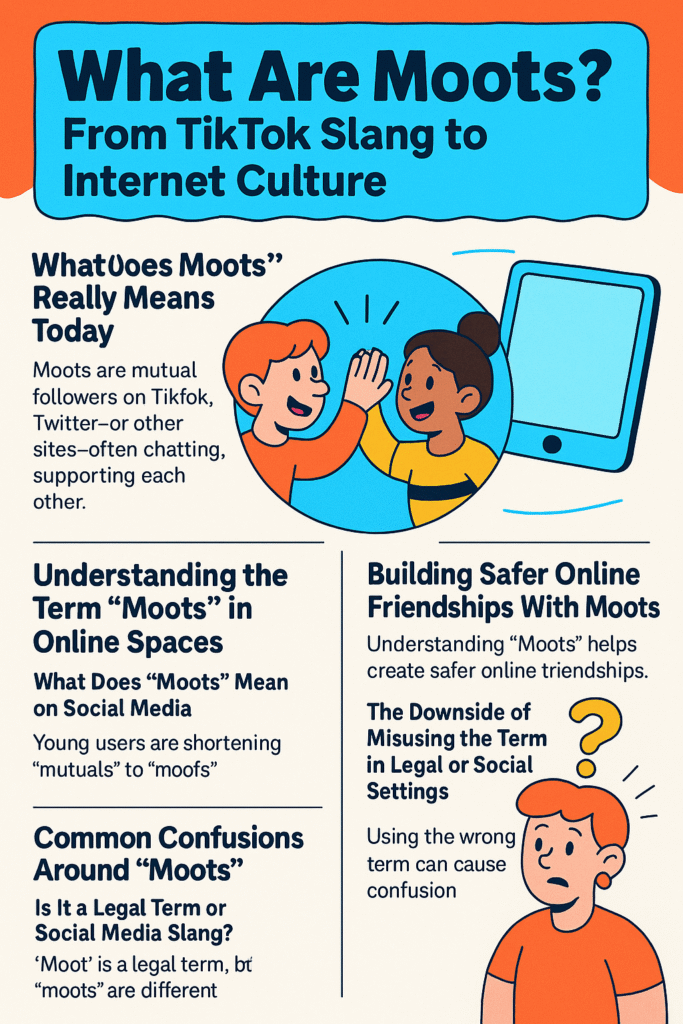If you’ve been scrolling on TikTok, Twitter (now X), or any popular social platform, you might’ve come across the term “moots” and wondered what it means. It’s not just a word thrown around for fun—it has a real meaning and a place in today’s online culture.
Originally short for “mutuals,” moots are people who follow each other back on a social app. They’re not just fans or followers—they’re people you interact with, post with, and maybe even become real friends with. But “moots” can also cause confusion. Some think it’s a legal word, others don’t know how to use it. Let’s break it down.
Understanding the Term “Moots” in Online Spaces
What Does “Moots” Mean on Social Media?
On TikTok and Twitter, the word “moots” stands for mutual followers. You follow someone, they follow you back—that’s a moot. But it’s more than that. Moots often chat in DMs, tag each other in posts, and build mini-communities within a bigger platform.
For many users, moots are their online circle. They’re who you trust, laugh with, and share posts only moots would get. Whether it’s trending fan edits, jokes, or support, moots are the backbone of digital friendship.
The Origin of the Word “Moot” in Digital Lingo
The term comes from the word “mutuals”, but over time, young users began shortening it to “moots.” It first gained popularity on Twitter and soon made its way to TikTok. Unlike traditional friendships, moots are based on shared content, vibes, and mutual engagement—not real-life connections.
Interestingly, “moot” is also a legal word. In law school, a “moot court” is a fake trial where students practice arguing. This often causes confusion, but in the world of Gen Z, it means mutuals—plain and simple.
Why Knowing What Moots Are Actually Matters
Building Safer Online Friendships With Moots
Understanding who your moots are can help create safer, more positive spaces online. When you know who you’re engaging with, you’re more likely to build trust. Many teens and creators have groups of moots they talk to regularly for support, memes, or even just casual banter.
Platforms like Instagram, Discord, and even Snapchat now revolve around community-like interactions. Calling someone your moot means you’ve crossed that invisible line from “random follower” to “someone I like having around.”
The Downside of Misusing the Term in Legal or Social Settings
Using the word “moots” in the wrong way can make things awkward. For instance, calling someone a moot in a business meeting or in a legal debate can create confusion. Remember, outside of social media, the word “moot” means something different.
In professional or educational settings, misusing slang like moots might make you look unprepared or not serious. It’s always best to understand your audience before using internet terms.
Common Confusions Around “Moots”
Is It a Legal Term or Social Media Slang?
Yes, “moot” is a legal term, but “moots” (with an ‘s’) is not. In law, something is moot if it’s no longer relevant to the case. And a moot court is where law students argue pretend cases.
This is very different from saying “my moots are so funny today” on TikTok. That’s why it’s important to know the context. In court, it’s a law word. On social, it means mutuals.
What Happens When People Misunderstand the Context?
Using “moots” in a mixed crowd can cause confusion. Some older users might ask, “What’s a moot?” Others may think you’re referencing law school. It’s a small word with a big meaning shift, depending on where and how it’s used.
A simple way to clear it up? Just explain. Say: “Moots are people I follow and who follow me back. We talk a lot online.” Easy.
How to Use the Word “Moots” Correctly
Talking to Your TikTok Friends Like a Pro
When someone says, “Looking for moots,” they mean they want new friends who will follow back and vibe with their content. It’s a common phrase in comments and captions. To use it right, just reply with your interests or follow someone back and say, “Hey moot!”
Want to connect better? Create content that your moots would enjoy, comment on their posts, and keep the conversation flowing. Being a good moot means being present and respectful.
Avoiding Cringe: Social Rules for Moots
Even though moots are your mutuals, that doesn’t mean you can spam them or ask for personal info. There are still boundaries. Some people may not want DMs or close contact, and that’s okay.
Good rule: Treat moots like real friends, but with a bit of online distance. Respect privacy, be kind, and never overshare unless you’re comfortable.
Conclusion: More Than Just a Trendy Term
Moots may seem like just another TikTok slang, but they represent something much bigger: online connection. In a world where social media often feels cold and crowded, moots help us feel seen.
From Twitter threads to TikTok dances, moots are the people who stick around, laugh at your jokes, and support your content. And while it may have started as a small slang term, it now shapes how we form digital friendships in the modern age.
So the next time someone says, “Tag your moots,” you’ll know exactly what to do—and who they are.

